Scrum Master’s Retrospective Guide
Your Complete ScrumMaster’s Guide to Running Fun Easy and Effective Sprint Retrospectives
Choose the best retrospective template for your meeting
Setting the Stage for Success: How to choose the best retrospective template for your meeting?
What is retrospective template?
A retrospective template is both a guide for and a record of a retrospective meeting. It takes the form of a board that includes simple prompts designed to facilitate a team’s reflection of their last sprint. It is also where responses to those prompts can be captured. Once the retrospective template is populated, it is then used as the foundation for discussions that will shape the team’s next steps.
Retrospective templates can come in a variety of forms. They can be built using whiteboards and markers, flip charts and pens, or even windows with post-its. They can be delivered online using a range of collaborative tools from virtual whiteboards to the online retrospective templates curated by TeamRetro.
Why are retrospective templates important?
Retrospective templates are important because they help to maximize the success of the retrospective meeting. As mentioned in Chapter Two – Why are retrospectives a useful agile tool? the meeting is a chance for the team to come together to reflect on their sprint. During the meeting, they share, explore and propose ideas that will help them improve. This came with the caveat that the retrospective must be run with intention and focus, as well as be engaging and time-efficient. The retrospective template is the tool that helps to deliver that intent, focus, engagement, and efficiency.
As well as supporting all five of Derby and Larsen’s sprint retrospective process steps that we touched upon in Chapter 1 – What is a sprint retrospective?, a retrospective template delivers a lot of value. A template –
- helps set the tone of the meeting
- provides a framework for ideation and discussion
- allows all participants to contribute equally, so it encourages engagement, fosters collaboration, and supports equity
- provides focus and reinforces the purpose of the meeting
- facilitates the easy capture of ideas
When delivered online, retrospective templates are particularly beneficial. As well as delivering the above value, they can also –
- deliver a clear structure that supports a transparent meeting process
- allow participants to contribute anonymously. This helps to address group-think, ensure all voices are heard, and support psychologically safety
- automatically capture ideas and comments inputted by participants, significantly streamlining the meeting documentation process
- automatically generate reports that can be shared with all participants
- be used online with co-located, remote, and hybrid teams
Additionally, a template can be leveraged to –
- energize the team
- support team connectedness and team building
- reinforce the Scrum Values
- open the lines of communication to safely address issues
or even
- help make the meeting fun
In short, the impressive range of retrospective templates available can help a Scrum Master address an equally impressive number of anti-patterns and team issues.
Why change retrospective templates?
There are two important reasons a Scrum Master should regularly change the retrospective template they use. First of all, change itself is valuable for the team. Secondly, different retrospective templates can help to deliver different benefits.
Change helps us improve. It helps us progress, develop and deliver new things. It offers us variety and fresh perspectives that spark creativity. In a nutshell, change helps us grow.
Simply by changing the template used to support a retrospective meeting, a Scrum Master can offer their team a fresh lens through which they can view their last sprint. With a different template, the team is gently calibrated to consider different words, phrases, and fresh perspectives.
At the same time, the Scrum Master helps to side-step the potential monotony sometimes inherent in regular meetings. This also helps mitigate the risk of team members allowing their ‘retro autopilot’ to kick in; when they offer standard or cliched feedback rather than considered and creative responses.
How do I choose the right retrospective template for my meeting?
Choosing the right retrospective template boils down to what you hope to achieve with your team during your Sprint Retrospective.
Your choice of retrospective template can be informed by a number of factors. One approach is to consider where you wish the team to focus –
- People (this includes communication and connectedness)
- Process (how you do what you do)
- Product (the vehicle to deliver value)
Another approach is to consider context –
- That of the team (interests, maturity, size, diversity)
- That of the Scrum Master (new to Scrum, highly experienced)
- That of the last sprint (everything went wrong, it was ok, it was great)
The choice of the template could also be behaviourally based –
- Specific anti-patterns you wish to address
- Aspects of psychological safety you wish to support
- Elements of play you hope to foster
Need a hand choosing?
We have a created a retrosective template picker tool to help you find the best retrospective template for your next meeting
Of course, all good templates should deliver meetings that are: engaging and focussed; relevant and purposeful, and productive and fun. What follows are some of the retrospective templates we use and the additional benefits we have found they offer.
The retrospective template to use if you’ve never retro’ed before
If you’re preparing to run your first retrospective you can’t go past the agile retrospective template.
Agile

The Agile retrospective asks four basic questions that gets the team thinking about the outcomes of the last sprint, and what actions they should focus on next.
While it is straightforward, it sends a clear message that you are listening and geared for improvement.
Great retrospective templates to use to support people
A supported team is a productive team. Here are three of the templates we use that deliver effective meetings and shine a spotlight on team empowerment and support.
Four Ls

The Four L’s retrospective presents your team with the opportunity to share both thoughts and feelings about their last sprint in a safe way.
You can use it to gain insight into how they prefer to be supported and their aspirations.
Personal Growth
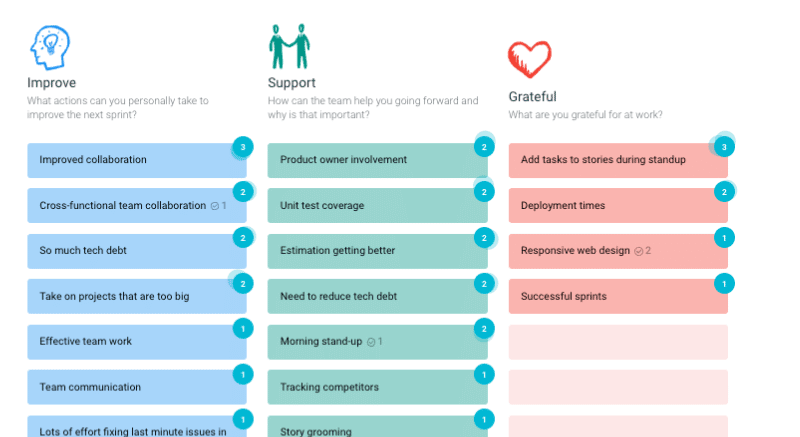
The Personal Growth retrospective has been designed to support the empowerment and well-being of your team members.
It gives each team the space to set goals and identify how others can support their efforts.
Scrum Values

The Scrum Value retrospective is a deep dive into the behaviors and actions each person takes in their daily life and work practices that reflect the values of Scrum.
It’s an opportunity to explore the connection between the Scrum Values and those of the team.
The best retrospective templates to use to support the process
When things aren’t progressing as well as planned it might be time to look at processes. These are three of the templates we use when it comes to process. They help us drill down into what’s happening and help us shape steps to get things back on track.
Stop Start Continue

The Start Stop Continue retrospective throws processes into sharp focus.
It’s a great tool to hone in on actions and quickly identify those that deliver value and those that don’t.
KALM

The KALM retrospective creates a safe space in which a team can fine-tune its processes.
It promotes a sense of agency and utility allowing the team to come up with ideas to help them move forward.
Starfish

The Starfish retrospective supports an examination of the varying degrees of value delivered by actions and activities.
It helps the team look at current practices and which ones should have more or less energy directed towards them.
The best retrospective templates to support product management
A Scrum Team’s purpose is to deliver outputs that address the requirements of Stakeholders. Product management, therefore, is core to their success.
Must Should Could Won’t

The Must Should Could Won’t retrospective is a great tool that offers the team a mechanism to step into the shoes of a customer and view the product from their perspective.
It is a particularly useful tool to maintain focus on priorities for projects with a large number of feature requests and competing stakeholders.
Three Little Pigs
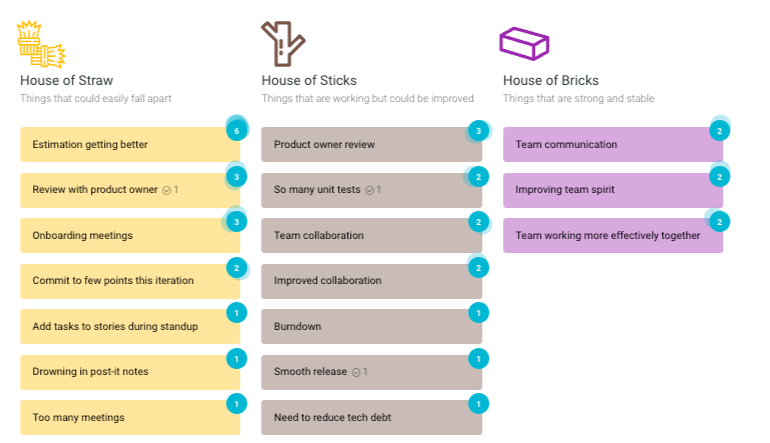
The Three Little Pigs retrospective offers your team a creative sprint retrospective idea to help identify short, medium, and long-term actions that will bring stability and value-added features to your product.
It helps analyze the current product or technology stack and which elements can be easily broken, need fixing up, or are part of the foundational core to deliver your service.
Rose Bud Thorn

The Rose, Bud, Thorn retrospective is an effective technique designed to help identify the positive outcomes, the opportunities, and the challenges from your last sprint.
This is a great retrospective to use if you wish to help remind your team to view challenges as manageable accompaniments to the delivery of value.
Great retrospectives to use if you’ve had a bad sprint
We’re human. We will have good days and bad days. Our team will have good sprints and bad sprints. When it comes to the bad, the important thing is we learn from them.
War stories
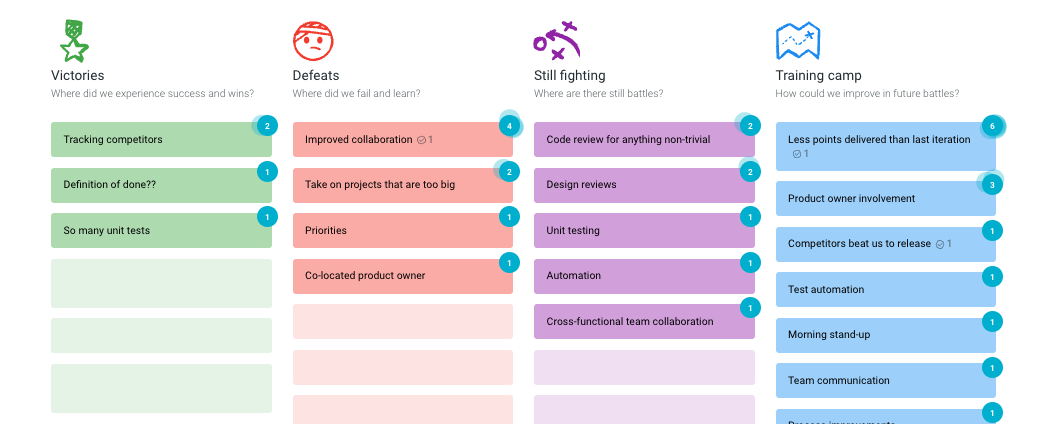
The War Stories retrospective offers a way for teams to share stories and relieve the tension of sprints that felt like battles.
With issues aired, they go on to forge strategies that will help them move forward together.
What? So what? Now what?
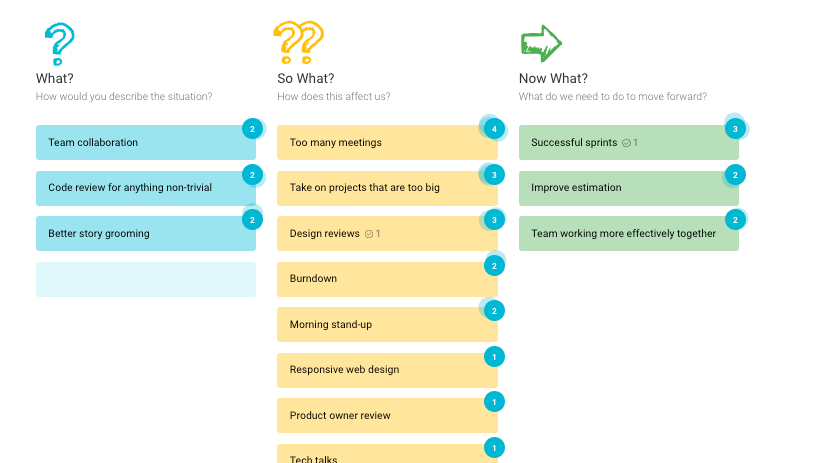
The What, so what, now what? retrospective was designed to bring a neutral pragmatism to the review of a sprint.
It helps your team suspend emotion and side-step bias in order to create a safely objective space to conduct your retrospective.
Working Not Working

The Working Not Working retrospective gets straight to the point. Its simplicity makes it impactful.
If your team needs a direct approach to get them moving again, then this is the retrospective template you should use.
Easy retrospectives to use when it’s time to have fun
Bringing an element of play into the workplace has been shown to deliver a myriad of benefits. It helps build teams and even supports individual well-being.
Witches and Warlocks

The Witches and Warlocks retrospective has been deliberately crafted to position team members to adopt an optimistic view of the sprint.
It’s a sprint retrospective idea that shows creativity and fun bring value to a project, and can be embraced without sacrificing productivity, focus or purpose.
Oscar Academy
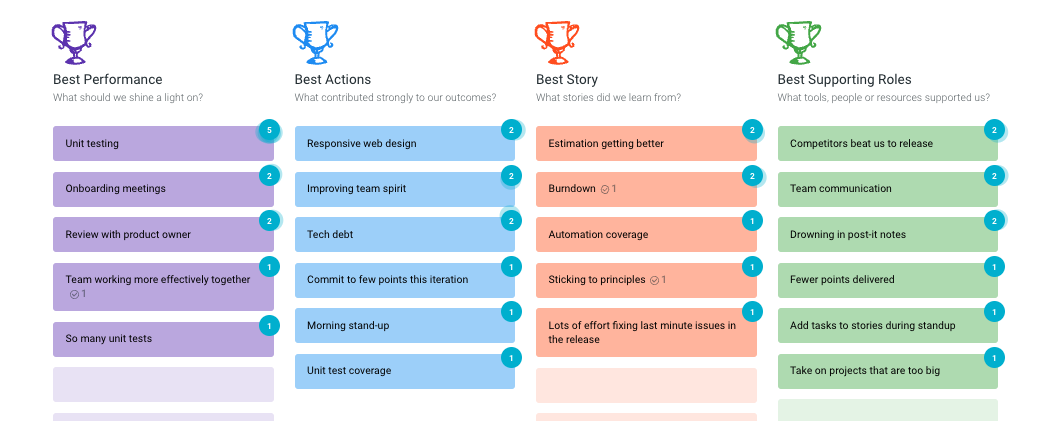
The Oscar Academy retrospective creates a stage where people can learn from stories, are recognized for their contributions, and celebrate their successes.
It embraces deliberate cheerfulness as a gentle reminder to team members to adopt a perspective of optimism when reflecting on the sprint.
Superhero

The Superhero retrospective is a fun, creative exercise that can be especially engaging for remote teams that have to come together to solve a common problem or work towards a goal.
Of course, each team has its own set of superpowers, but they will also have their vulnerabilities and this retrospective template can help uncover these.
You can check out more templates here.
4.8 on
Capterra





Trusted by 26,000+ agile teams and growing
Try it free for 30 days, no credit card required
Still have questions? SCHEDULE A DEMO